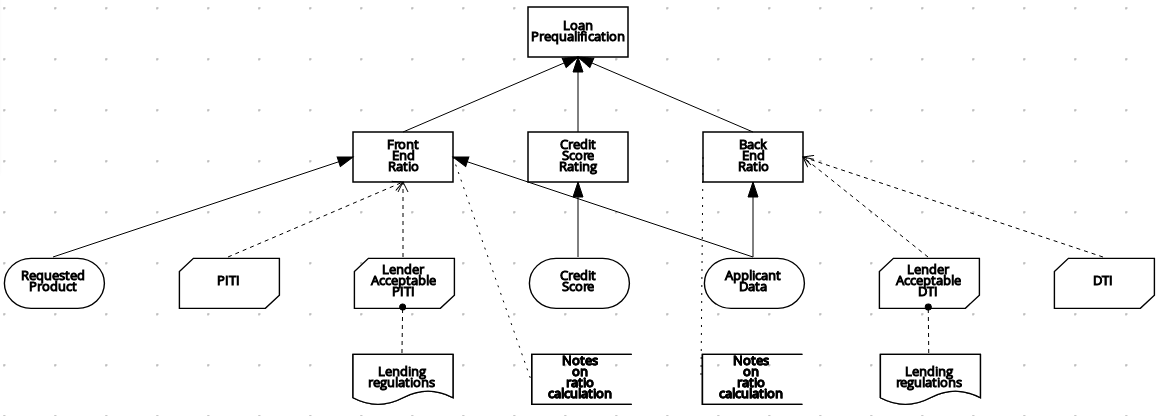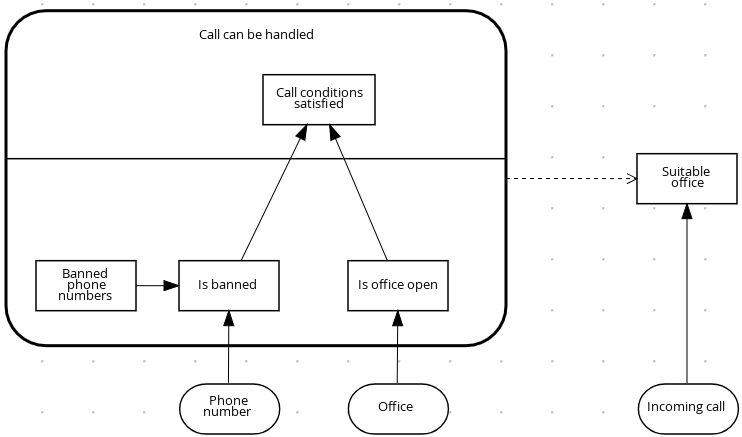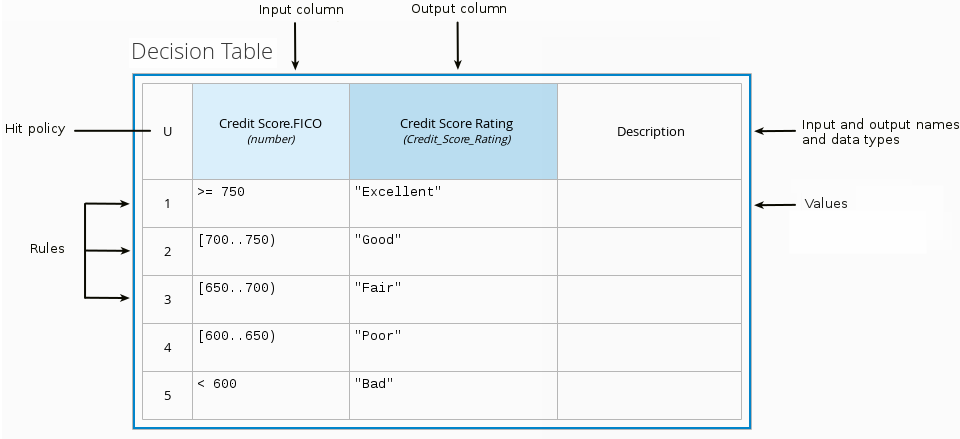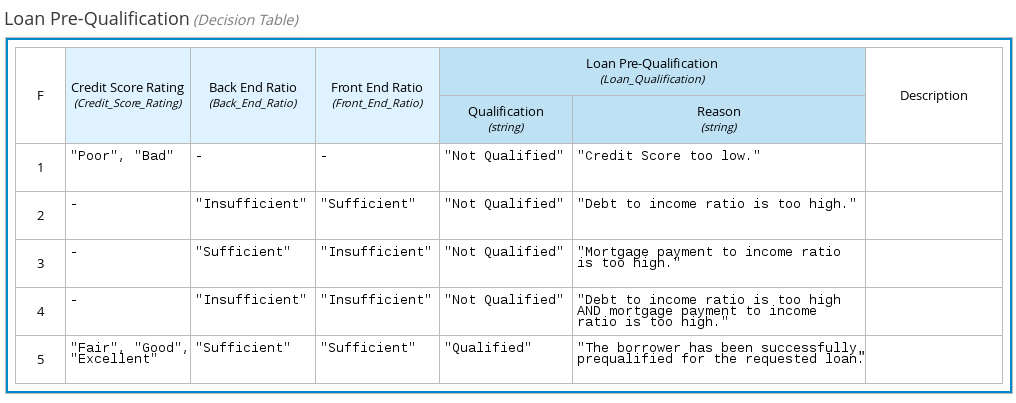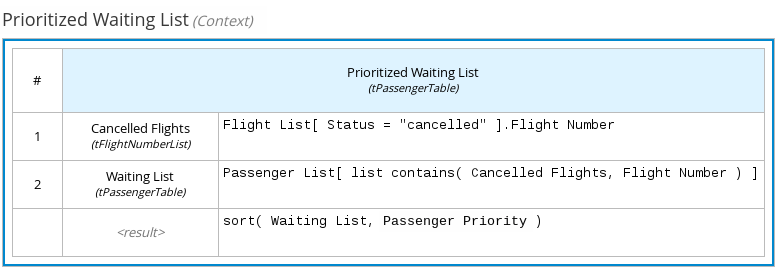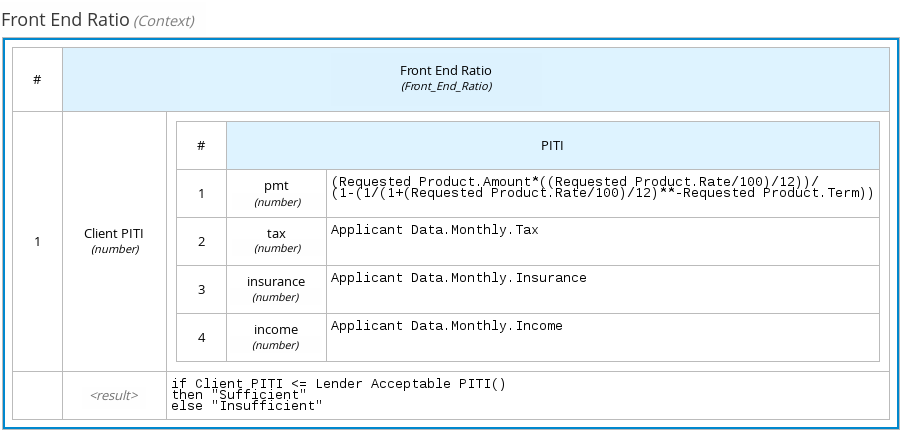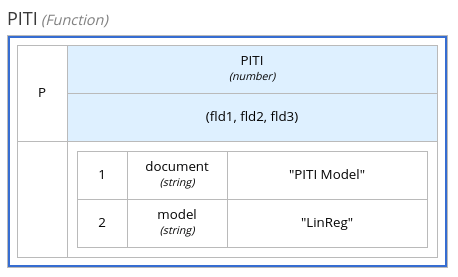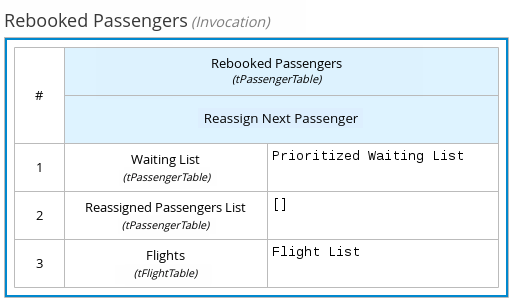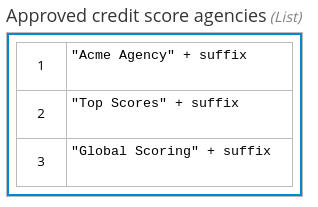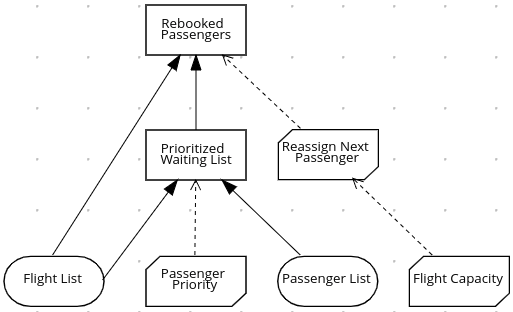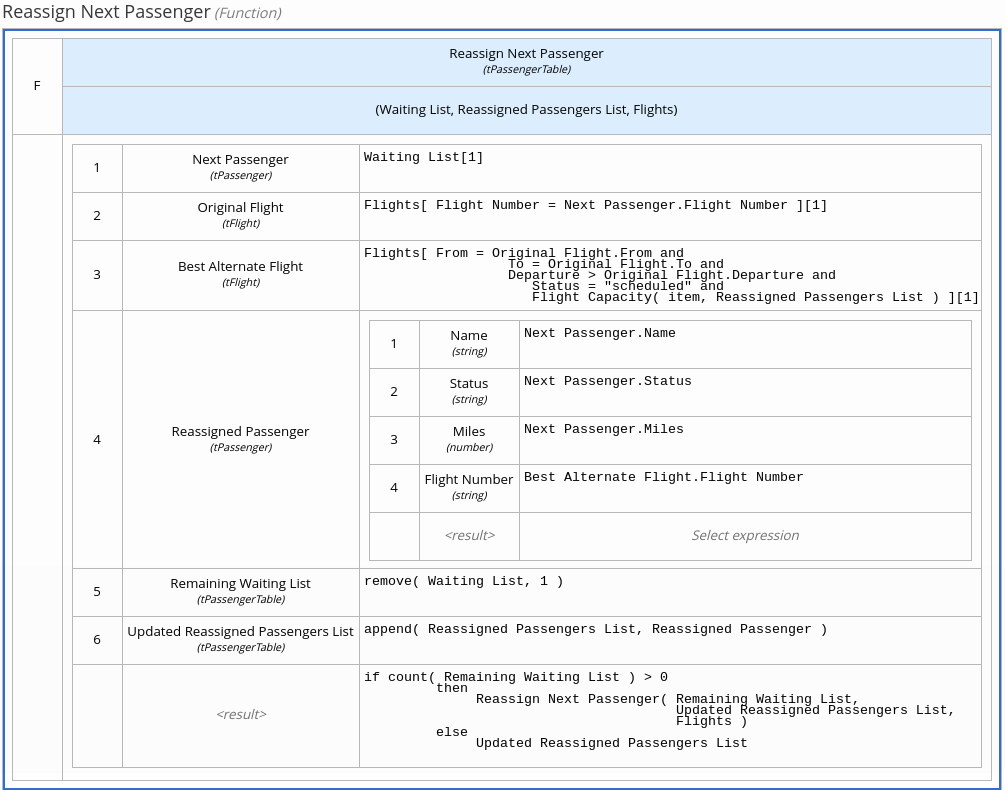Chapter 1. Decision Model and Notation (DMN)
Decision Model and Notation (DMN) is a standard established by the Object Management Group (OMG) for describing and modeling operational decisions. DMN defines an XML schema that enables DMN models to be shared between DMN-compliant platforms and across organizations so that business analysts and business rules developers can collaborate in designing and implementing DMN decision services. The DMN standard is similar to and can be used together with the Business Process Model and Notation (BPMN) standard for designing and modeling business processes.
For more information about the background and applications of DMN, see the OMG Decision Model and Notation specification.
1.1. DMN conformance levels
The DMN specification defines three incremental levels of conformance in a software implementation. A product that claims compliance at one level must also be compliant with any preceding levels. For example, a conformance level 3 implementation must also include the supported components in conformance levels 1 and 2. For the formal definitions of each conformance level, see the OMG Decision Model and Notation specification.
The following list summarizes the three DMN conformance levels:
- Conformance level 1
- A DMN conformance level 1 implementation supports decision requirement diagrams (DRDs), decision logic, and decision tables, but decision models are not executable. Any language can be used to define the expressions, including natural, unstructured languages.
- Conformance level 2
- A DMN conformance level 2 implementation includes the requirements in conformance level 1, and supports Simplified Friendly Enough Expression Language (S-FEEL) expressions and fully executable decision models.
- Conformance level 3
- A DMN conformance level 3 implementation includes the requirements in conformance levels 1 and 2, and supports Friendly Enough Expression Language (FEEL) expressions, the full set of boxed expressions, and fully executable decision models.
Red Hat Decision Manager provides design and runtime support for DMN 1.2 models at conformance level 3, and runtime-only support for DMN 1.1 and 1.3 models at conformance level 3. You can design your DMN models directly in Business Central or import existing DMN models into your Red Hat Decision Manager projects for deployment and execution. Any DMN 1.1 models that you import into Business Central, open in the DMN designer, and save are converted to DMN 1.2 models. DMN 1.3 models are not supported in the DMN designer in Business Central.
1.2. DMN decision requirements diagram (DRD) components
A decision requirements diagram (DRD) is a visual representation of your DMN model. This diagram consists of one or more decision requirements graphs (DRGs) that represent a particular domain of an overall DRD. The DRGs trace business decisions using decision nodes, business knowledge models, sources of business knowledge, input data, and decision services.
The following table summarizes the components in a DRD:
| Component | Description | Notation | |
|---|---|---|---|
| Elements | Decision | Node where one or more input elements determine an output based on defined decision logic. | |
| Business knowledge model | Reusable function with one or more decision elements. Decisions that have the same logic but depend on different sub-input data or sub-decisions use business knowledge models to determine which procedure to follow. | ||
| Knowledge source | External authorities, documents, committees, or policies that regulate a decision or business knowledge model. Knowledge sources are references to real-world factors rather than executable business rules. | ||
| Input data | Information used in a decision node or a business knowledge model. Input data usually includes business-level concepts or objects relevant to the business, such as loan applicant data used in a lending strategy. | ||
| Decision service | Top-level decision containing a set of reusable decisions published as a service for invocation. A decision service can be invoked from an external application or a BPMN business process. | ||
| Requirement connectors | Information requirement | Connection from an input data node or decision node to another decision node that requires the information. | |
| Knowledge requirement | Connection from a business knowledge model to a decision node or to another business knowledge model that invokes the decision logic. | ||
| Authority requirement | Connection from an input data node or a decision node to a dependent knowledge source or from a knowledge source to a decision node, business knowledge model, or another knowledge source. | ||
| Artifacts | Text annotation | Explanatory note associated with an input data node, decision node, business knowledge model, or knowledge source. | |
| Association | Connection from an input data node, decision node, business knowledge model, or knowledge source to a text annotation. | ||
The following table summarizes the permitted connectors between DRD elements:
| Starts from | Connects to | Connection type | Example |
|---|---|---|---|
| Decision | Decision | Information requirement | |
| Business knowledge model | Decision | Knowledge requirement | |
| Business knowledge model | |||
| Decision service | Decision | Knowledge requirement | |
| Business knowledge model | |||
| Input data | Decision | Information requirement | |
| Knowledge source | Authority requirement | ||
| Knowledge source | Decision | Authority requirement | |
| Business knowledge model | |||
| Knowledge source | |||
| Decision | Text annotation | Association | |
| Business knowledge model | |||
| Knowledge source | |||
| Input data |
The following example DRD illustrates some of these DMN components in practice:
Figure 1.1. Example DRD: Loan prequalification
The following example DRD illustrates DMN components that are part of a reusable decision service:
Figure 1.2. Example DRD: Phone call handling as a decision service
In a DMN decision service node, the decision nodes in the bottom segment incorporate input data from outside of the decision service to arrive at a final decision in the top segment of the decision service node. The resulting top-level decisions from the decision service are then implemented in any subsequent decisions or business knowledge requirements of the DMN model. You can reuse DMN decision services in other DMN models to apply the same decision logic with different input data and different outgoing connections.
1.3. Rule expressions in FEEL
Friendly Enough Expression Language (FEEL) is an expression language defined by the Object Management Group (OMG) DMN specification. FEEL expressions define the logic of a decision in a DMN model. FEEL is designed to facilitate both decision modeling and execution by assigning semantics to the decision model constructs. FEEL expressions in decision requirements diagrams (DRDs) occupy table cells in boxed expressions for decision nodes and business knowledge models.
For more information about FEEL in DMN, see the OMG Decision Model and Notation specification.
1.3.1. Variable and function names in FEEL
Unlike many traditional expression languages, Friendly Enough Expression Language (FEEL) supports spaces and a few special characters as part of variable and function names. A FEEL name must start with a letter, ?, or _ element. The unicode letter characters are also allowed. Variable names cannot start with a language keyword, such as and, true, or every. The remaining characters in a variable name can be any of the starting characters, as well as digits, white spaces, and special characters such as +, -, /, *, ', and ..
For example, the following names are all valid FEEL names:
- Age
- Birth Date
- Flight 234 pre-check procedure
Several limitations apply to variable and function names in FEEL:
- Ambiguity
-
The use of spaces, keywords, and other special characters as part of names can make FEEL ambiguous. The ambiguities are resolved in the context of the expression, matching names from left to right. The parser resolves the variable name as the longest name matched in scope. You can use
( )to disambiguate names if necessary. - Spaces in names
The DMN specification limits the use of spaces in FEEL names. According to the DMN specification, names can contain multiple spaces but not two consecutive spaces.
In order to make the language easier to use and avoid common errors due to spaces, Red Hat Decision Manager removes the limitation on the use of consecutive spaces. Red Hat Decision Manager supports variable names with any number of consecutive spaces, but normalizes them into a single space. For example, the variable references
First Namewith one space andFirst Namewith two spaces are both acceptable in Red Hat Decision Manager.Red Hat Decision Manager also normalizes the use of other white spaces, like the non-breakable white space that is common in web pages, tabs, and line breaks. From a Red Hat Decision Manager FEEL engine perspective, all of these characters are normalized into a single white space before processing.
- The keyword
in -
The keyword
inis the only keyword in the language that cannot be used as part of a variable name. Although the specifications allow the use of keywords in the middle of variable names, the use ofinin variable names conflicts with the grammar definition offor,everyandsomeexpression constructs.
1.3.2. Data types in FEEL
Friendly Enough Expression Language (FEEL) supports the following data types:
- Numbers
- Strings
- Boolean values
- Dates
- Time
- Date and time
- Days and time duration
- Years and months duration
- Functions
- Contexts
- Ranges (or intervals)
- Lists
The DMN specification currently does not provide an explicit way of declaring a variable as a function, context, range, or list, but Red Hat Decision Manager extends the DMN built-in types to support variables of these types.
The following list describes each data type:
- Numbers
Numbers in FEEL are based on the IEEE 754-2008 Decimal 128 format, with 34 digits of precision. Internally, numbers are represented in Java as
BigDecimalswithMathContext DECIMAL128. FEEL supports only one number data type, so the same type is used to represent both integers and floating point numbers.FEEL numbers use a dot (
.) as a decimal separator. FEEL does not support-INF,+INF, orNaN. FEEL usesnullto represent invalid numbers.Red Hat Decision Manager extends the DMN specification and supports additional number notations:
-
Scientific: You can use scientific notation with the suffix
e<exp>orE<exp>. For example,1.2e3is the same as writing the expression1.2*10**3, but is a literal instead of an expression. -
Hexadecimal: You can use hexadecimal numbers with the prefix
0x. For example,0xffis the same as the decimal number255. Both uppercase and lowercase letters are supported. For example,0XFFis the same as0xff. -
Type suffixes: You can use the type suffixes
f,F,d,D,l, andL. These suffixes are ignored.
-
Scientific: You can use scientific notation with the suffix
- Strings
Strings in FEEL are any sequence of characters delimited by double quotation marks.
Example:
"John Doe"
"John Doe"Copy to Clipboard Copied! Toggle word wrap Toggle overflow - Boolean values
-
FEEL uses three-valued boolean logic, so a boolean logic expression may have values
true,false, ornull. - Dates
Date literals are not supported in FEEL, but you can use the built-in
date()function to construct date values. Date strings in FEEL follow the format defined in the XML Schema Part 2: Datatypes document. The format is"YYYY-MM-DD"whereYYYYis the year with four digits,MMis the number of the month with two digits, andDDis the number of the day.Example:
date( "2017-06-23" )
date( "2017-06-23" )Copy to Clipboard Copied! Toggle word wrap Toggle overflow Date objects have time equal to
"00:00:00", which is midnight. The dates are considered to be local, without a timezone.- Time
Time literals are not supported in FEEL, but you can use the built-in
time()function to construct time values. Time strings in FEEL follow the format defined in the XML Schema Part 2: Datatypes document. The format is"hh:mm:ss[.uuu][(+-)hh:mm]"wherehhis the hour of the day (from00to23),mmis the minutes in the hour, andssis the number of seconds in the minute. Optionally, the string may define the number of milliseconds (uuu) within the second and contain a positive (+) or negative (-) offset from UTC time to define its timezone. Instead of using an offset, you can use the letterzto represent the UTC time, which is the same as an offset of-00:00. If no offset is defined, the time is considered to be local.Examples:
time( "04:25:12" ) time( "14:10:00+02:00" ) time( "22:35:40.345-05:00" ) time( "15:00:30z" )
time( "04:25:12" ) time( "14:10:00+02:00" ) time( "22:35:40.345-05:00" ) time( "15:00:30z" )Copy to Clipboard Copied! Toggle word wrap Toggle overflow Time values that define an offset or a timezone cannot be compared to local times that do not define an offset or a timezone.
- Date and time
Date and time literals are not supported in FEEL, but you can use the built-in
date and time()function to construct date and time values. Date and time strings in FEEL follow the format defined in the XML Schema Part 2: Datatypes document. The format is"<date>T<time>", where<date>and<time>follow the prescribed XML schema formatting, conjoined byT.Examples:
date and time( "2017-10-22T23:59:00" ) date and time( "2017-06-13T14:10:00+02:00" ) date and time( "2017-02-05T22:35:40.345-05:00" ) date and time( "2017-06-13T15:00:30z" )
date and time( "2017-10-22T23:59:00" ) date and time( "2017-06-13T14:10:00+02:00" ) date and time( "2017-02-05T22:35:40.345-05:00" ) date and time( "2017-06-13T15:00:30z" )Copy to Clipboard Copied! Toggle word wrap Toggle overflow Date and time values that define an offset or a timezone cannot be compared to local date and time values that do not define an offset or a timezone.
ImportantIf your implementation of the DMN specification does not support spaces in the XML schema, use the keyword
dateTimeas a synonym ofdate and time.- Days and time duration
Days and time duration literals are not supported in FEEL, but you can use the built-in
duration()function to construct days and time duration values. Days and time duration strings in FEEL follow the format defined in the XML Schema Part 2: Datatypes document, but are restricted to only days, hours, minutes and seconds. Months and years are not supported.Examples:
duration( "P1DT23H12M30S" ) duration( "P23D" ) duration( "PT12H" ) duration( "PT35M" )
duration( "P1DT23H12M30S" ) duration( "P23D" ) duration( "PT12H" ) duration( "PT35M" )Copy to Clipboard Copied! Toggle word wrap Toggle overflow ImportantIf your implementation of the DMN specification does not support spaces in the XML schema, use the keyword
dayTimeDurationas a synonym ofdays and time duration.- Years and months duration
Years and months duration literals are not supported in FEEL, but you can use the built-in
duration()function to construct days and time duration values. Years and months duration strings in FEEL follow the format defined in the XML Schema Part 2: Datatypes document, but are restricted to only years and months. Days, hours, minutes, or seconds are not supported.Examples:
duration( "P3Y5M" ) duration( "P2Y" ) duration( "P10M" ) duration( "P25M" )
duration( "P3Y5M" ) duration( "P2Y" ) duration( "P10M" ) duration( "P25M" )Copy to Clipboard Copied! Toggle word wrap Toggle overflow ImportantIf your implementation of the DMN specification does not support spaces in the XML schema, use the keyword
yearMonthDurationas a synonym ofyears and months duration.- Functions
FEEL has
functionliterals (or anonymous functions) that you can use to create functions. The DMN specification currently does not provide an explicit way of declaring a variable as afunction, but Red Hat Decision Manager extends the DMN built-in types to support variables of functions.Example:
function(a, b) a + b
function(a, b) a + bCopy to Clipboard Copied! Toggle word wrap Toggle overflow In this example, the FEEL expression creates a function that adds the parameters
aandband returns the result.- Contexts
FEEL has
contextliterals that you can use to create contexts. Acontextin FEEL is a list of key and value pairs, similar to maps in languages like Java. The DMN specification currently does not provide an explicit way of declaring a variable as acontext, but Red Hat Decision Manager extends the DMN built-in types to support variables of contexts.Example:
{ x : 5, y : 3 }{ x : 5, y : 3 }Copy to Clipboard Copied! Toggle word wrap Toggle overflow In this example, the expression creates a context with two entries,
xandy, representing a coordinate in a chart.In DMN 1.2, another way to create contexts is to create an item definition that contains the list of keys as attributes, and then declare the variable as having that item definition type.
The Red Hat Decision Manager DMN API supports DMN
ItemDefinitionstructural types in aDMNContextrepresented in two ways:-
User-defined Java type: Must be a valid JavaBeans object defining properties and getters for each of the components in the DMN
ItemDefinition. If necessary, you can also use the@FEELPropertyannotation for those getters representing a component name which would result in an invalid Java identifier. -
java.util.Mapinterface: The map needs to define the appropriate entries, with the keys corresponding to the component name in the DMNItemDefinition.
-
User-defined Java type: Must be a valid JavaBeans object defining properties and getters for each of the components in the DMN
- Ranges (or intervals)
FEEL has
rangeliterals that you can use to create ranges or intervals. Arangein FEEL is a value that defines a lower and an upper bound, where either can be open or closed. The DMN specification currently does not provide an explicit way of declaring a variable as arange, but Red Hat Decision Manager extends the DMN built-in types to support variables of ranges.The syntax of a range is defined in the following formats:
Copy to Clipboard Copied! Toggle word wrap Toggle overflow The expression for the endpoint must return a comparable value, and the lower bound endpoint must be lower than the upper bound endpoint.
For example, the following literal expression defines an interval between
1and10, including the boundaries (a closed interval on both endpoints):[ 1 .. 10 ]
[ 1 .. 10 ]Copy to Clipboard Copied! Toggle word wrap Toggle overflow The following literal expression defines an interval between 1 hour and 12 hours, including the lower boundary (a closed interval), but excluding the upper boundary (an open interval):
[ duration("PT1H") .. duration("PT12H") )[ duration("PT1H") .. duration("PT12H") )Copy to Clipboard Copied! Toggle word wrap Toggle overflow You can use ranges in decision tables to test for ranges of values, or use ranges in simple literal expressions. For example, the following literal expression returns
trueif the value of a variablexis between0and100:x in [ 1 .. 100 ]
x in [ 1 .. 100 ]Copy to Clipboard Copied! Toggle word wrap Toggle overflow - Lists
FEEL has
listliterals that you can use to create lists of items. Alistin FEEL is represented by a comma-separated list of values enclosed in square brackets. The DMN specification currently does not provide an explicit way of declaring a variable as alist, but Red Hat Decision Manager extends the DMN built-in types to support variables of lists.Example:
[ 2, 3, 4, 5 ]
[ 2, 3, 4, 5 ]Copy to Clipboard Copied! Toggle word wrap Toggle overflow All lists in FEEL contain elements of the same type and are immutable. Elements in a list can be accessed by index, where the first element is
1. Negative indexes can access elements starting from the end of the list so that-1is the last element.For example, the following expression returns the second element of a list
x:x[2]
x[2]Copy to Clipboard Copied! Toggle word wrap Toggle overflow The following expression returns the second-to-last element of a list
x:x[-2]
x[-2]Copy to Clipboard Copied! Toggle word wrap Toggle overflow Elements in a list can also be counted by the function
count, which uses the list of elements as the parameter.For example, the following expression returns
4:count([ 2, 3, 4, 5 ])
count([ 2, 3, 4, 5 ])Copy to Clipboard Copied! Toggle word wrap Toggle overflow
1.4. DMN decision logic in boxed expressions
Boxed expressions in DMN are tables that you use to define the underlying logic of decision nodes and business knowledge models in a decision requirements diagram (DRD) or decision requirements graph (DRG). Some boxed expressions can contain other boxed expressions, but the top-level boxed expression corresponds to the decision logic of a single DRD artifact. While DRDs with one or more DRGs represent the flow of a DMN decision model, boxed expressions define the actual decision logic of individual nodes. DRDs and boxed expressions together form a complete and functional DMN decision model.
The following are the types of DMN boxed expressions:
- Decision tables
- Literal expressions
- Contexts
- Relations
- Functions
- Invocations
- Lists
Red Hat Decision Manager does not provide boxed list expressions in Business Central, but supports a FEEL list data type that you can use in boxed literal expressions. For more information about the list data type and other FEEL data types in Red Hat Decision Manager, see Section 1.3.2, “Data types in FEEL”.
All Friendly Enough Expression Language (FEEL) expressions that you use in your boxed expressions must conform to the FEEL syntax requirements in the OMG Decision Model and Notation specification.
1.4.1. DMN decision tables
A decision table in DMN is a visual representation of one or more business rules in a tabular format. You use decision tables to define rules for a decision node that applies those rules at a given point in the decision model. Each rule consists of a single row in the table, and includes columns that define the conditions (input) and outcome (output) for that particular row. The definition of each row is precise enough to derive the outcome using the values of the conditions. Input and output values can be FEEL expressions or defined data type values.
For example, the following decision table determines credit score ratings based on a defined range of a loan applicant’s credit score:
Figure 1.3. Decision table for credit score rating
The following decision table determines the next step in a lending strategy for applicants depending on applicant loan eligibility and the bureau call type:
Figure 1.4. Decision table for lending strategy
The following decision table determines applicant qualification for a loan as the concluding decision node in a loan prequalification decision model:
Figure 1.5. Decision table for loan prequalification
Decision tables are a popular way of modeling rules and decision logic, and are used in many methodologies (such as DMN) and implementation frameworks (such as Drools).
Red Hat Decision Manager supports both DMN decision tables and Drools-native decision tables, but they are different types of assets with different syntax requirements and are not interchangeable. For more information about Drools-native decision tables in Red Hat Decision Manager, see Designing a decision service using spreadsheet decision tables.
1.4.1.1. Hit policies in DMN decision tables
Hit policies determine how to reach an outcome when multiple rules in a decision table match the provided input values. For example, if one rule in a decision table applies a sales discount to military personnel and another rule applies a discount to students, then when a customer is both a student and in the military, the decision table hit policy must indicate whether to apply one discount or the other (Unique, First) or both discounts (Collect Sum). You specify the single character of the hit policy (U, F, C+) in the upper-left corner of the decision table.
The following decision table hit policies are supported in DMN:
- Unique (U): Permits only one rule to match. Any overlap raises an error.
- Any (A): Permits multiple rules to match, but they must all have the same output. If multiple matching rules do not have the same output, an error is raised.
- Priority (P): Permits multiple rules to match, with different outputs. The output that comes first in the output values list is selected.
- First (F): Uses the first match in rule order.
Collect (C+, C>, C<, C#): Aggregates output from multiple rules based on an aggregation function.
- Collect ( C ): Aggregates values in an arbitrary list.
- Collect Sum (C+): Outputs the sum of all collected values. Values must be numeric.
- Collect Min (C<): Outputs the minimum value among the matches. The resulting values must be comparable, such as numbers, dates, or text (lexicographic order).
- Collect Max (C>): Outputs the maximum value among the matches. The resulting values must be comparable, such as numbers, dates or text (lexicographic order).
- Collect Count (C#): Outputs the number of matching rules.
1.4.2. Boxed literal expressions
A boxed literal expression in DMN is a literal FEEL expression as text in a table cell, typically with a labeled column and an assigned data type. You use boxed literal expressions to define simple or complex node logic or decision data directly in FEEL for a particular node in a decision. Literal FEEL expressions must conform to FEEL syntax requirements in the OMG Decision Model and Notation specification.
For example, the following boxed literal expression defines the minimum acceptable PITI calculation (principal, interest, taxes, and insurance) in a lending decision, where acceptable rate is a variable defined in the DMN model:
Figure 1.6. Boxed literal expression for minimum PITI value
The following boxed literal expression sorts a list of possible dating candidates (soul mates) in an online dating application based on their score on criteria such as age, location, and interests:
Figure 1.7. Boxed literal expression for matching online dating candidates
1.4.3. Boxed context expressions
A boxed context expression in DMN is a set of variable names and values with a result value. Each name-value pair is a context entry. You use context expressions to represent data definitions in decision logic and set a value for a desired decision element within the DMN decision model. A value in a boxed context expression can be a data type value or FEEL expression, or can contain a nested sub-expression of any type, such as a decision table, a literal expression, or another context expression.
For example, the following boxed context expression defines the factors for sorting delayed passengers in a flight-rebooking decision model, based on defined data types (tPassengerTable, tFlightNumberList):
Figure 1.8. Boxed context expression for flight passenger waiting list
The following boxed context expression defines the factors that determine whether a loan applicant can meet minimum mortgage payments based on principal, interest, taxes, and insurance (PITI), represented as a front-end ratio calculation with a sub-context expression:
Figure 1.9. Boxed context expression for front-end client PITI ratio
1.4.4. Boxed relation expressions
A boxed relation expression in DMN is a traditional data table with information about given entities, listed as rows. You use boxed relation tables to define decision data for relevant entities in a decision at a particular node. Boxed relation expressions are similar to context expressions in that they set variable names and values, but relation expressions contain no result value and list all variable values based on a single defined variable in each column.
For example, the following boxed relation expression provides information about employees in an employee rostering decision:
Figure 1.10. Boxed relation expression with employee information
1.4.5. Boxed function expressions
A boxed function expression in DMN is a parameterized boxed expression containing a literal FEEL expression, a nested context expression of an external JAVA or PMML function, or a nested boxed expression of any type. By default, all business knowledge models are defined as boxed function expressions. You use boxed function expressions to call functions on your decision logic and to define all business knowledge models.
For example, the following boxed function expression determines airline flight capacity in a flight-rebooking decision model:
Figure 1.11. Boxed function expression for flight capacity
The following boxed function expression contains a basic Java function as a context expression for determining absolute value in a decision model calculation:
Figure 1.12. Boxed function expression for absolute value
The following boxed function expression determines a monthly mortgage installment as a business knowledge model in a lending decision, with the function value defined as a nested context expression:
Figure 1.13. Boxed function expression for installment calculation in business knowledge model
The following boxed function expression uses a PMML model included in the DMN file to define the minimum acceptable PITI calculation (principal, interest, taxes, and insurance) in a lending decision:
Figure 1.14. Boxed function expression with an included PMML model in business knowledge model
1.4.6. Boxed invocation expressions
A boxed invocation expression in DMN is a boxed expression that invokes a business knowledge model. A boxed invocation expression contains the name of the business knowledge model to be invoked and a list of parameter bindings. Each binding is represented by two boxed expressions on a row: The box on the left contains the name of a parameter and the box on the right contains the binding expression whose value is assigned to the parameter to evaluate the invoked business knowledge model. You use boxed invocations to invoke at a particular decision node a business knowledge model defined in the decision model.
For example, the following boxed invocation expression invokes a Reassign Next Passenger business knowledge model as the concluding decision node in a flight-rebooking decision model:
Figure 1.15. Boxed invocation expression to reassign flight passengers
The following boxed invocation expression invokes an InstallmentCalculation business knowledge model to calculate a monthly installment amount for a loan before proceeding to affordability decisions:
Figure 1.16. Boxed invocation expression for required monthly installment
1.4.7. Boxed list expressions
A boxed list expression in DMN represents a FEEL list of items. You use boxed lists to define lists of relevant items for a particular node in a decision. You can also use literal FEEL expressions for list items in cells to create more complex lists.
For example, the following boxed list expression identifies approved credit score agencies in a loan application decision service:
Figure 1.17. Boxed list expression for approved credit score agencies
The following boxed list expression also identifies approved credit score agencies but uses FEEL logic to define the agency status (Inc., LLC, SA, GA) based on a DMN input node:
Figure 1.18. Boxed list expression using FEEL logic for approved credit score agency status
1.5. DMN model example
The following is a real-world DMN model example that demonstrates how you can use decision modeling to reach a decision based on input data, circumstances, and company guidelines. In this scenario, a flight from San Diego to New York is canceled, requiring the affected airline to find alternate arrangements for its inconvenienced passengers.
First, the airline collects the information necessary to determine how best to get the travelers to their destinations:
- Input data
- List of flights
- List of passengers
- Decisions
- Prioritize the passengers who will get seats on a new flight
- Determine which flights those passengers will be offered
- Business knowledge models
- The company process for determining passenger priority
- Any flights that have space available
- Company rules for determining how best to reassign inconvenienced passengers
The airline then uses the DMN standard to model its decision process in the following decision requirements diagram (DRD) for determining the best rebooking solution:
Figure 1.19. DRD for flight rebooking
Similar to flowcharts, DRDs use shapes to represent the different elements in a process. Ovals contain the two necessary input data, rectangles contain the decision points in the model, and rectangles with clipped corners (business knowledge models) contain reusable logic that can be repeatedly invoked.
The DRD draws logic for each element from boxed expressions that provide variable definitions using FEEL expressions or data type values.
Some boxed expressions are basic, such as the following decision for establishing a prioritized waiting list:
Figure 1.20. Boxed context expression example for prioritized wait list
Some boxed expressions are more complex with greater detail and calculation, such as the following business knowledge model for reassigning the next delayed passenger:
Figure 1.21. Boxed function expression for passenger reassignment
The following is the DMN source file for this decision model:
























